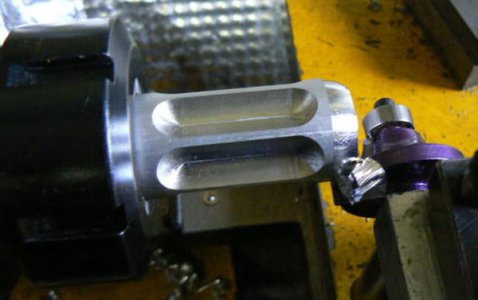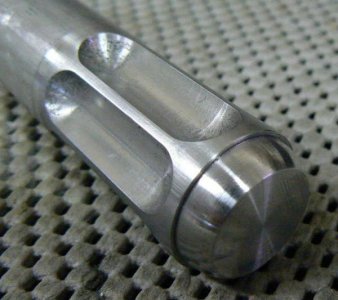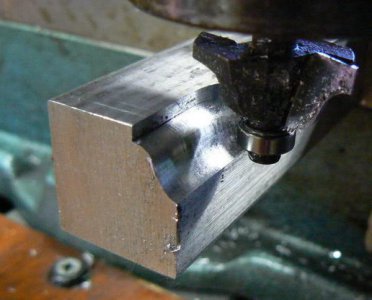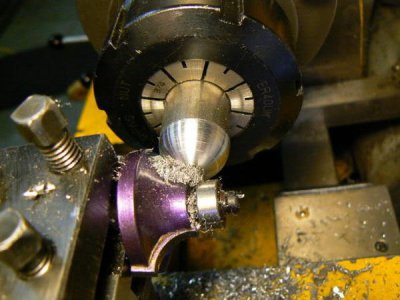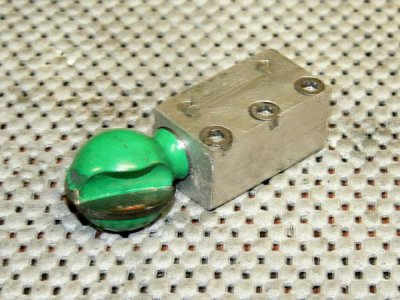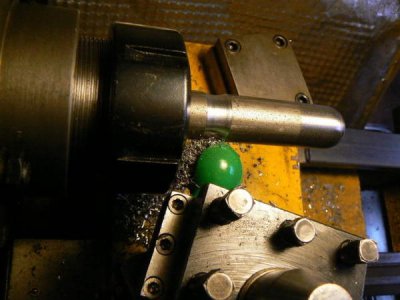- Joined
- Feb 5, 2015
- Messages
- 662
Where to locate this post was sort of ambiguous to me. I thought about it for a while and decided to put it here as perhaps being most useful to those with limited experience. However there ARE safety considerations and those who are new to this craft are well-advised to carefully consider every step of this process before attempting it. As with all machining operations, you risk injury so be VERY careful !
About ten years ago, I operated a one-man consulting business out of my home. Some design projects required “proof of concept” models. “Proof of concept” means that I needed to validate calculated performance with actual measurements.
The majority of my work dealt with high frequency RF and microwave components/systems but heat exchangers are frequently required in these products. One such project required the miniature heat exchanger shown partly completed below.
In this case, my customer didn’t require proof of concept but I was nervous about the predicted performance of this device. These types of heat exchangers are NOT simply a matter of mating a fan to a finned extrusion. The process is VERY complicated; for example here is a typical discussion, picked at random from the internet:
http://www.brighthubengineering.com/hvac/124367-heat-exchanger-designs/
My intuition didn’t support my calculated heat exchange figures so I made this model (on my own time) to measure performance and provide some reassurance.
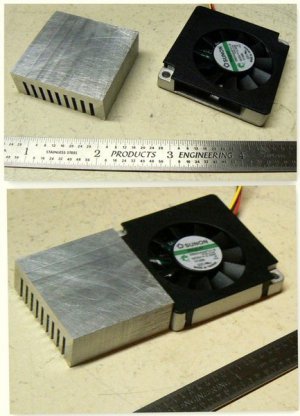
The narrow, deep slots were a challenge because at that time, some years ago, I didn’t yet own a horizontal mill - which would have produced the finned part in a few minutes. There was NO way that I was going to attempt to make the slots with a small end mill, even if I could find one with flutes long enough for the slot depth.
In several of my posts on the forum, I’ve mentioned using router cutters in both lathe and milling machines and this problem also suggested a similar solution... I had a vague recollection of seeing some router slotting cutters at the H-F store. Yep, a return visit found this cutter kit (for less than $20 IIRC).
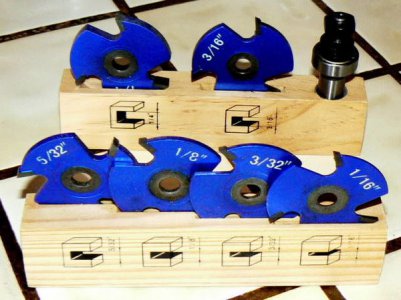
An arbor came with the kit but I didn’t completely trust it. I discarded it and made one similar to the following CAD sketch. Note that the cutter is not held by friction alone but slides over two pins that are pressed into the arbor.
The cutters need two clearance holes drilled for the pins but that's no problem since the cutters are unhardened except for the brazed carbide "teeth". Should the cutter slip under cutting load, the two pins will provide the driving torque.
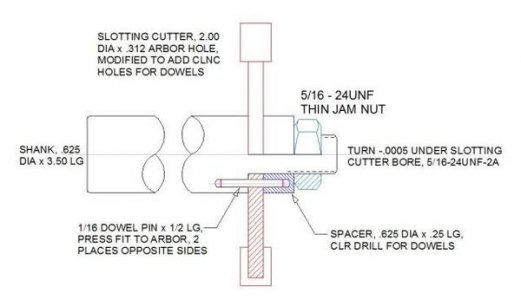
Although this is not the same part as the heat exchanger, the slotting process was performed in the same straightforward manner using the vertical mill:
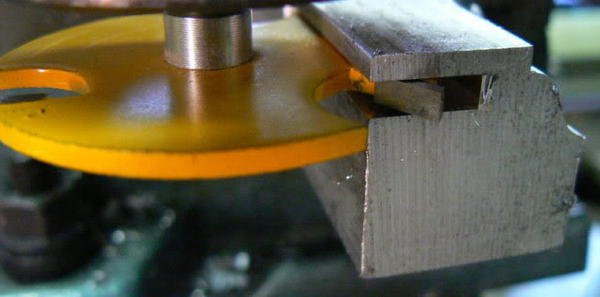
CAUTION is required when this type of operation is performed. The spindle speed must be appropriate both for the material to be slotted AND the diameter of the slotting tool. If the arbor doesn't have a means of positively locking the cutter (in other words, the cutter is held to the arbor only by friction) there is a possibility of the cutter slipping on the arbor.
The results might be unhappy AND unsafe. You must be aware of this possibility at all times and be prepared to stop feeding and turn off the machine ! If the arbor slips, it is almost always visible but another indication is any increase in the pressure required to feed the cutter.
You must also insure that the workpiece is clamped securely. Before commencing the cutting operation, tap the workpiece sharply with a small hammer in the same direction as the force that the cutter will apply. ANY possibility of the workpiece coming loose during milling will result in disaster !
A cutting fluid should be applied to the cutting edges continuously in a safe manner. Generally a small paint brush or "acid brush" occasionally dipped in cutting oil and applied by hand is adequate. However your hand must be shielded as will be discussed below.
The feed of the cutter must be uniform - jerky feed will cause the cutter to "dig into" the work, possibly causing the brazed joint that attaches the carbide "teeth" to fail, flinging the piece of carbide out of the cut at high speed. Power feeding the cutter is not a good idea - it's important to "feel" the resistance of the cutting process.
It's always good practice when swinging a large cutter, like a flycutter, a boring head (especially when the boring tool is held horizontally) or a slotting tool, to place a temporary shield on the mill table between the cutter and the operator. If something flies loose (especially in the case of a flycutter or boring head) you definitely want something between you and the flying object ! It doesn't have to be very sophisticated, an "L" shaped plywood shield is fine.
After setting up the heat exchanger and the miniature blower in my electronics lab, I mounted a variable thermal source to the heat exchanger, enabled the tiny blower and made temperature measurements with an infra-red pyrometer. Happily the measured results were not too far divergent from the calculated ones.
At a later date, I wrote a brief paper comparing various ways to predict finned heat exchanger performance using finite element analysis (FEA) rather than rigorous calculation. If anyone is interested, it can be found here:
http://lisafea.com/pdf/Comparing_FEA_Models.pdf
About ten years ago, I operated a one-man consulting business out of my home. Some design projects required “proof of concept” models. “Proof of concept” means that I needed to validate calculated performance with actual measurements.
The majority of my work dealt with high frequency RF and microwave components/systems but heat exchangers are frequently required in these products. One such project required the miniature heat exchanger shown partly completed below.
In this case, my customer didn’t require proof of concept but I was nervous about the predicted performance of this device. These types of heat exchangers are NOT simply a matter of mating a fan to a finned extrusion. The process is VERY complicated; for example here is a typical discussion, picked at random from the internet:
http://www.brighthubengineering.com/hvac/124367-heat-exchanger-designs/
My intuition didn’t support my calculated heat exchange figures so I made this model (on my own time) to measure performance and provide some reassurance.

The narrow, deep slots were a challenge because at that time, some years ago, I didn’t yet own a horizontal mill - which would have produced the finned part in a few minutes. There was NO way that I was going to attempt to make the slots with a small end mill, even if I could find one with flutes long enough for the slot depth.
In several of my posts on the forum, I’ve mentioned using router cutters in both lathe and milling machines and this problem also suggested a similar solution... I had a vague recollection of seeing some router slotting cutters at the H-F store. Yep, a return visit found this cutter kit (for less than $20 IIRC).

An arbor came with the kit but I didn’t completely trust it. I discarded it and made one similar to the following CAD sketch. Note that the cutter is not held by friction alone but slides over two pins that are pressed into the arbor.
The cutters need two clearance holes drilled for the pins but that's no problem since the cutters are unhardened except for the brazed carbide "teeth". Should the cutter slip under cutting load, the two pins will provide the driving torque.

Although this is not the same part as the heat exchanger, the slotting process was performed in the same straightforward manner using the vertical mill:

CAUTION is required when this type of operation is performed. The spindle speed must be appropriate both for the material to be slotted AND the diameter of the slotting tool. If the arbor doesn't have a means of positively locking the cutter (in other words, the cutter is held to the arbor only by friction) there is a possibility of the cutter slipping on the arbor.
The results might be unhappy AND unsafe. You must be aware of this possibility at all times and be prepared to stop feeding and turn off the machine ! If the arbor slips, it is almost always visible but another indication is any increase in the pressure required to feed the cutter.
You must also insure that the workpiece is clamped securely. Before commencing the cutting operation, tap the workpiece sharply with a small hammer in the same direction as the force that the cutter will apply. ANY possibility of the workpiece coming loose during milling will result in disaster !
A cutting fluid should be applied to the cutting edges continuously in a safe manner. Generally a small paint brush or "acid brush" occasionally dipped in cutting oil and applied by hand is adequate. However your hand must be shielded as will be discussed below.
The feed of the cutter must be uniform - jerky feed will cause the cutter to "dig into" the work, possibly causing the brazed joint that attaches the carbide "teeth" to fail, flinging the piece of carbide out of the cut at high speed. Power feeding the cutter is not a good idea - it's important to "feel" the resistance of the cutting process.
It's always good practice when swinging a large cutter, like a flycutter, a boring head (especially when the boring tool is held horizontally) or a slotting tool, to place a temporary shield on the mill table between the cutter and the operator. If something flies loose (especially in the case of a flycutter or boring head) you definitely want something between you and the flying object ! It doesn't have to be very sophisticated, an "L" shaped plywood shield is fine.
After setting up the heat exchanger and the miniature blower in my electronics lab, I mounted a variable thermal source to the heat exchanger, enabled the tiny blower and made temperature measurements with an infra-red pyrometer. Happily the measured results were not too far divergent from the calculated ones.
At a later date, I wrote a brief paper comparing various ways to predict finned heat exchanger performance using finite element analysis (FEA) rather than rigorous calculation. If anyone is interested, it can be found here:
http://lisafea.com/pdf/Comparing_FEA_Models.pdf
Last edited:

